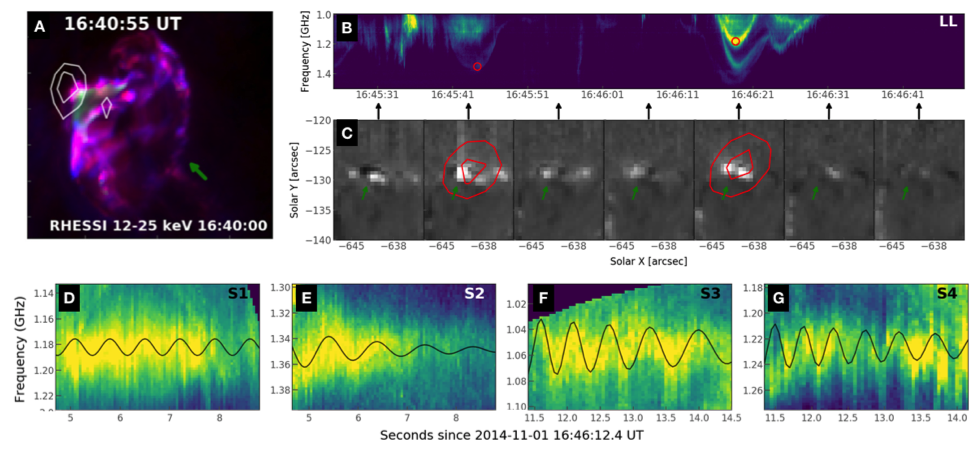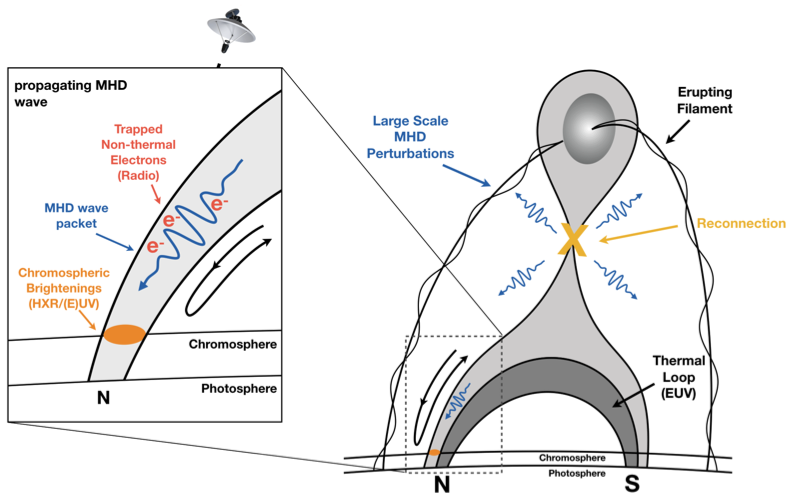Solar flares involve the sudden release of magnetic energy in the solar corona. Accelerated nonthermal electrons have been often invoked as the primary means for transporting the bulk of the released energy to the lower solar atmosphere. However, significant challenges remain for this scenario, especially in accounting for the large number of accelerated electrons inferred from observations. Propagating magnetohydrodynamics (MHD) waves, particularly those with subsecond/second-scale periods, have been proposed as an alternative means for transporting the released flare energy likely alongside the electron beams[1-3], while observational evidence remains elusive. Here we report possible observational evidence for these subsecond-period fast-mode MHD waves[4] in the late impulsive phase of a two-ribbon flare. This is based on ultra-high cadence dynamic imaging spectroscopic observations of a peculiar type of decimetric (“dm-λ”) radio bursts obtained by the Karl G. Jansky Very Large Array (VLA).
Decimetric Radio Bursts Associated with (E)UV Brightenings
The dm-λ bursts were observed by the VLA in 1.0-1.5 GHz during a GOES-class C7.2 solar flare [5], shown as Figure 1(A). Two main episodes can be distinguished in the dynamic spectrum (Figure 1(B)). The bursts appear as multiple arch-shaped emission lanes in the dynamic spectrum, which display a low-high-low frequency drift pattern with a moderate relative frequency drift rate of $\dot{\nu}/\nu\lesssim 0.2s^{-1}$. The drift rate is about one order of magnitude lower than type III radio bursts emitted by beams of fast electrons, but similar to fiber bursts and lace bursts in the same frequency range. Such bursts with an intermediate frequency drift rate are sometimes referred to as “intermediate drift bursts”[6].

Figure 1: (A) Composite EUV image of SDO/AIA showing the flare context. Contours are 12-25 keV HXR emission by RHESSI during the early flare impulsive phase. (B) VLA cross-power dynamic spectrum showing the dm-λ bursts. (C) AIA 304 Å background-detrended image sequence at times marked by the black vertical arrows in (B), showing the EUV ribbon brightenings near the radio sources. Red contours are the radio sources that correspond to the bursts (the time and frequency are marked in the dynamic spectrum of panel A as red circles). Green arrows indicate the location of the transient EUV brightening. (D-G) Detrended dynamic spectra of emission lanes of the second dm-λ burst, showing the subsecond-scale oscillations in the emission frequency.
Radio imaging of the bursts places the burst source (red contours) near the northern flare ribbon, as shown in Figure 1(C). Background in Figure 1(C) is the detrended AIA 304 Å image sequence during the same time interval of the radio dynamic spectrum shown in panel B. During this period, the northern ribbon is featured by the appearance of two transient EUV brightenings during radio bursts, and the location of the brightenings is very close to the radio source. The appearance of the radio source during the flare impulsive phase, as well as its close spatial and temporal association with the ribbon brightenings, suggests that the radio source is intimately related to the release and transport of the flare energy.
More detailed inspection of the dynamic spectral features of the stronger burst reveals multitudes of very short, subsecond-scale fine structures on each emission lane. Figure 1(D)-(G) show emission lanes for the burst that have been detrended to remove their overall frequency drift pattern. The bursts appear to oscillate in their emission frequency around the central “ridge” of the emission lane quasi-periodically with period of ~0.3-1 s and damping times of ~0.5-5 s in amplitude.
Radio Dynamic Spectroscopic Imaging
The capability of simultaneous imaging and dynamic spectroscopy offered by the VLA allows each pixel in the dynamic spectrum to form a radio image. The radio source first moves toward the flare ribbon as frequency increases until it reaches the maximum frequency at the lowest height, and then bounces back to the opposite direction away from the ribbon as frequency decreases. The average speed in projection is ~1000-2000 km s-1, which is typical for propagating Alfvén or fast-mode magnetosonic waves in the low corona. This is a strong indication for the radio emission being associated with a propagating Alfvén or fast-mode MHD disturbance in a magnetic tube in the close vicinity of the flare ribbon.
Nature of the propagating radio source
We interpret the observed radio bursts as short-period, weakly compressible fast-mode magnetosonic wave packets, likely triggered by the impulsive flare energy release, propagating along newly reconnected magnetic flux tubes (serving as waveguides) linking to the flare ribbon (see Figure 2 for a schematic). The observed reflection of the waves at or near the flare ribbon may be due to sharp gradients at and/or below the transition region. The small-amplitude oscillations in frequency can be interpreted as weak density perturbations associated with the propagating MHD waves. As stated in the Introduction section, subsecond-period MHD waves may be a viable mechanism responsible for transporting a substantial amount of the magnetic energy released in the corona downward to the lower atmosphere, resulting in intense plasma heating and/or particle acceleration. From the observed density oscillations and the source speed, we estimate that these wave packets carry an energy flux of 2-8×108 erg s-1 cm-2, which is comparable to the average energy flux required for driving the flare heating during the late impulsive phase of the flare estimated from the UV ribbon brightenings.

Figure 2: Schematic illustration of the observed radio bursts of interest. The impulsive energy release associated with the filament eruption and the two-ribbon flare generates ubiquitous MHD disturbances, some of which propagate along newly reconnected field lines in the form of MHD wave packets that contain multiple subsecond-period oscillations. Electrons trapped or accelerated within these wave packets generate Langmuir waves and convert to radio emission. Some of the wave packets can reflect at or near the flare ribbon due to sharp gradients, resulting in the observed spatial motion of the radio source and the low-high-low frequency drift pattern of the radio burst in the dynamic spectrum. The (E)UV brightenings at the flare ribbon may be associated with heating by the precipitated energetic electrons or the deposited wave energy.
Conclusions
We report possible detection of subsecond-period propagating MHD Waves in post-reconnection magnetic loops during the late impulsive phase of a two-ribbon flare, based on imaging spectroscopic observations of a peculiar type of dm-λ radio bursts recorded by the VLA. The radio source, propagating at 1000–2000 km s-1 in projection, shows close spatial and temporal association with transient brightenings on the flare ribbon. In addition, multitudes of subsecond-period oscillations are present in the radio emission. We interpret the observed radio bursts as short-period fast-mode MHD wave packets propagating along newly reconnected magnetic flux tubes linking to the flare ribbon. The estimated energy flux (2-8×108 erg s-1 cm-2) carried by the waves is comparable to that needed to account for the plasma heating during the late impulsive phase of this flare.
Recently published in The Astrophysical Journal, 2019, 872, 1, id. 71 (16 pp.), doi: 10.3847/1538-4357/aaff6d
Reference
[1] Temperature minimum heating in solar flares by resistive dissipation of Alfven waves, Emslie, A. G., & Sturrock, P. A. 1982, SoPh, 80, 99
[2] Impulsive Phase Flare Energy Transport by Large-Scale Alfvén Waves and the Electron Acceleration Problem, Fletcher, L., & Hudson, H. S. 2008, ApJ, 675, 1645
[3] Solar flares and focused energy transport by MHD waves, Russell, A. J. B., & Stackhouse, D. J. 2013, A&A, 558, A76
[4] Origin of the Modulation of the Radio Emission from the Solar Corona by a Fast Magnetoacoustic Wave, Kolotkov, Dmitrii Y.; Nakariakov, Valery M.; Kontar, Eduard P, 2017, ApJ, 861, 33
[5] Possible Detection of Subsecond-Period Propagating Magnetohydrodynamics Waves in Post-Reconnection Magnetic Loops during a Two-Ribbon Solar Flare. Yu, Sijie & Chen, Bin. 2019, ApJ, 872, 1
[6] Intermediate drift bursts and the coronal magnetic field. Benz, A. O., & Mann, G. 1998, A&A, 333, 1034
Full list of authors: Sijie Yu and Bin Chen
